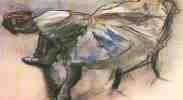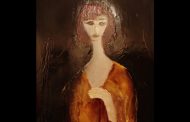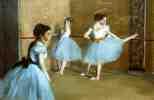
Edgar (Hilaire-Germain-) Degas, (b. July 19, 1834, Paris, Fr.–d. Sept. 27, 1917, Paris): French artist, acknowledged as the master of drawing the human figure in motion, Degas worked in many mediums, preferring pastel to all others. He is perhaps best known for his paintings, drawings, and bronzes of ballerinas and of race horses.
The art of Degas reflects a concern for the psychology of movement and expression and the harmony of line and continuity of contour. These characteristics set Degas apart from the other impressionist painters, although he took part in all but one of the 8 impressionist exhibitions between 1874 and 1886. Degas was the son of a wealthy banker, and his aristocratic family background instilled into his early art a haughty yet sensitive quality of detachment. As he grew up, his idol was the painter Jean Auguste Ingres, whose example pointed him in the direction of a classical draftsmanship, stressing balance and clarity of outline. After beginning his artistic studies with Louis Lamothes, a pupil of Ingres, he started classes at the Ecole des Beaux Arts but left in 1854 and went to Italy. He stayed there for 5 years, studying Italian art, especially Renaissance works.
Returning to Paris in 1859, he painted portraits of his family and friends and a number of historical subjects, in which he combined classical and romantic styles. In Paris, Degas came to know Édouard Manet, and in the late 1860s he turned to contemporary themes, painting both theatrical scenes and portraits with a strong emphasis on the social and intellectual implications of props and setting.
In the early 1870s the female ballet dancer became his favorite theme. He sketched from a live model in his studio and combined poses into groupings that depicted rehearsal and performance scenes in which dancers on stage, entering the stage, and resting or waiting to perform are shown simultaneously and in counterpoint, often from an oblique angle of vision. On a visit in 1872 to Louisiana, where he had relatives in the cotton business, he painted The Cotton Exchange at New Orleans (finished 1873; Musée Municipal, Pau, France), his only picture to be acquired by a museum in his lifetime. Other subjects from this period include the racetrack, the beach, and cafe interiors.
There are many great paintings to remind us that the artists of the Impressionist age were sensitively aware of contemporary life. Among the supreme masterpieces of the century are Degas’s pictures of the ballet and its dancers. The impulse towards painting the contemporary scene came to him not only from Courbet and Manet but from his friend, the critic Duranty, the exponent of the aesthetics of naturalism. Yet in the particular direction of his tastes and his conception of design he was entirely individual. To study and convey movement was a chosen task, first undertaken on the race course and then in his many pictures of the Opera, viewed from behind the scenes, in the wings, or from the orchestra stalls during a performance.
 Three Ballet Dancers, One with Dark Crimson Waist
Three Ballet Dancers, One with Dark Crimson Waist
1899 (170 Kb); Pastel on paper, 23 1/4 x 19 1/4 in; Barnes Foundation
Photograph by Charalambos Amvrosiou
 Rehearsal of a Ballet on Stage
Rehearsal of a Ballet on Stage
 The Singer in Green
The Singer in Green
Metropolitan Museum of Art, New York
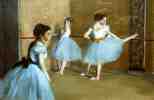 Dance Class at the Opéra
Dance Class at the Opéra
1872; detail; Musée d’Orsay, Paris
 La classe de danse (The Dancing class)
La classe de danse (The Dancing class)
c. 1873-75 (140 Kb); Oil on canvas, 85 x 75 cm (33 1/2 x 29 1/2 in); Musee d’Orsay, Paris
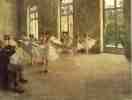 The Rehearsal
The Rehearsal
c. 1873-78 (120 Kb); Oil on canvas, 41 x 61.7 cm (18 1/2 x 24 3/8 in); Fogg Art Museum, Harvard University, Cambridge, MA
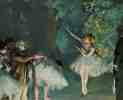 Ballet Rehearsal
Ballet Rehearsal
1875; Gouache and Pastel on canvas, 21-3/4″ x 27″; George G. Frelinghuysen Collection, N.Y.
 Singer with a Glove
Singer with a Glove
c. 1878 (110 Kb); Pastel and liquid medium on canvas, 52.8 x 41.1 cm (20 3/4 x 16 in); Fogg Art Museum, Harvard University, Cambridge, MA
 L’etoile [La danseuse sur la scene] (The Star [Dancer on Stage])
L’etoile [La danseuse sur la scene] (The Star [Dancer on Stage])
1878 (150 Kb); Pastel on paper, 60 x 44 cm (23 5/8 x 17 3/8 in); Musee d’Orsay, Paris
 Danseuse assise
Danseuse assise
c. 1879-80 (130 Kb); “Seated Dancer”; Charcoal and pastel on paper mounted on pasteboard, 63.5 x 48.7 cm (25 x 19 1/8 in); The Hermitage, St. Petersburg; No. GR 155-99. Formerly collection Otto Krebs, Holzdorf
 Three Dancers in Violet Tutues
Three Dancers in Violet Tutues
c. 1895-98; Signed lower left; Pastel on paper, 73.5 x 48.9 cm; The Phillips Family Collection (L.1339); on display at the Art Institute of Chicago (Degas Exhibition, 1996)
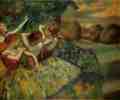 Four Dancers
Four Dancers
c. 1899 (150 Kb); Oil on canvas, 151.1 x 180.2 cm (59 1/2 x 71 in); National Gallery of Art, Washington
Sebastian Dal

